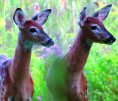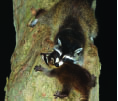All sorts of wildlife can be found on campus if you know where to look. Left to right: a pair of raccoons, and a barn swallow family, deer twins, and an Eastern painted turtle.
Walking around campus, nature is everywhere: willow trees tower over the Lanphier Center, turtles tan on the logs, and daffodils signal the arrival of spring. Join us this week as we meet Mr. Ian Morris, a Choate biology teacher of thirty-four years who has dedicated much of his time to photographing, preserving, and expanding campus wildlife for the entire community to enjoy.
According to Mr. Morris, Choate’s campus is a “wildlife oasis in a spreading fragmentation of industrial development and commercial housing development.” Unlike the rapidly disappearing Wallingford farms, Choate has maintained a place where wildlife can prosper and thrive. It acts both as a corridor and a bridge: wildlife can move to and from campus, linking the campus to other habitats.
The diverse ecosystems on campus, including wetlands, conifers, fields, and regenerating woodlands, encourage diverse animal wildlife. “I have seen coyotes when they were cubs, adolescents, and adults. They fascinate me. I love turkeys, and I like red-tailed hawks, mainly because of their interesting way of building the nests,” said Mr. Morris. He has even found raccoons residing in the (now cut-down) trees outside Mead House.
From mammals to birds to insects to microscopic life, Mr. Morris has photographed it all. His passion is especially evident in the wildlife display on the second floor of the science center. He took every one of the photographs. In fact, he humorously proclaimed, “I am a king photographer, and one of the reasons I chose to stay at Choate is the wildlife.”
Mr. Morris also emphasized the importance of preserving and looking after campus wildlife. On Earth Day, volunteers cut back invasive species, sometimes deliberately stopping the natural progression of vegetation in order to give space for various plant life.
“You can think of the few hundred acres of Choate as a giant garden in which we continuously plant, weed, and protect,” said Mr. Morris. “A significant portion of the school community studies Choate wildlife during the course of the year. Students can take courses in environmental science, global sciences, and woodland ecology, or participate in the KEC program. They see wildlife with field trips or simply by walking around campus.”
In some cases, Choate creates artificial environments for wildlife to prosper in. As Mr. Morris explained, “Ponds in front of Archbold and between Lanphier and the science center are artificial. The turtle logs are anchored by a rope, and the big willow trees next to Lanphier are planted by my children, who graduated from Choate over a decade ago. All the daffodils you see are planted by Environmental Action Coalition.” Other plant life dates much further back; for example, Choate boys planted oak trees on campus in 1928.
Although Mr. Morris’s contributions to the campus wildlife scene are certainly extraordinary, why should the ordinary Choate student care? Grace Kortum ’17, one of the leaders of Environmental Action Coalition, answered, “Humans have caused harm to the environment in a variety of ways, from carbon emissions and climate change to the destruction of wildlife habitats. We all carry responsibilities to help preserve wildlife, both for the sake of protecting ecosystems and biodiversity. This way, people in the future can experience and appreciate nature and wildlife as much as we are able to now.”








